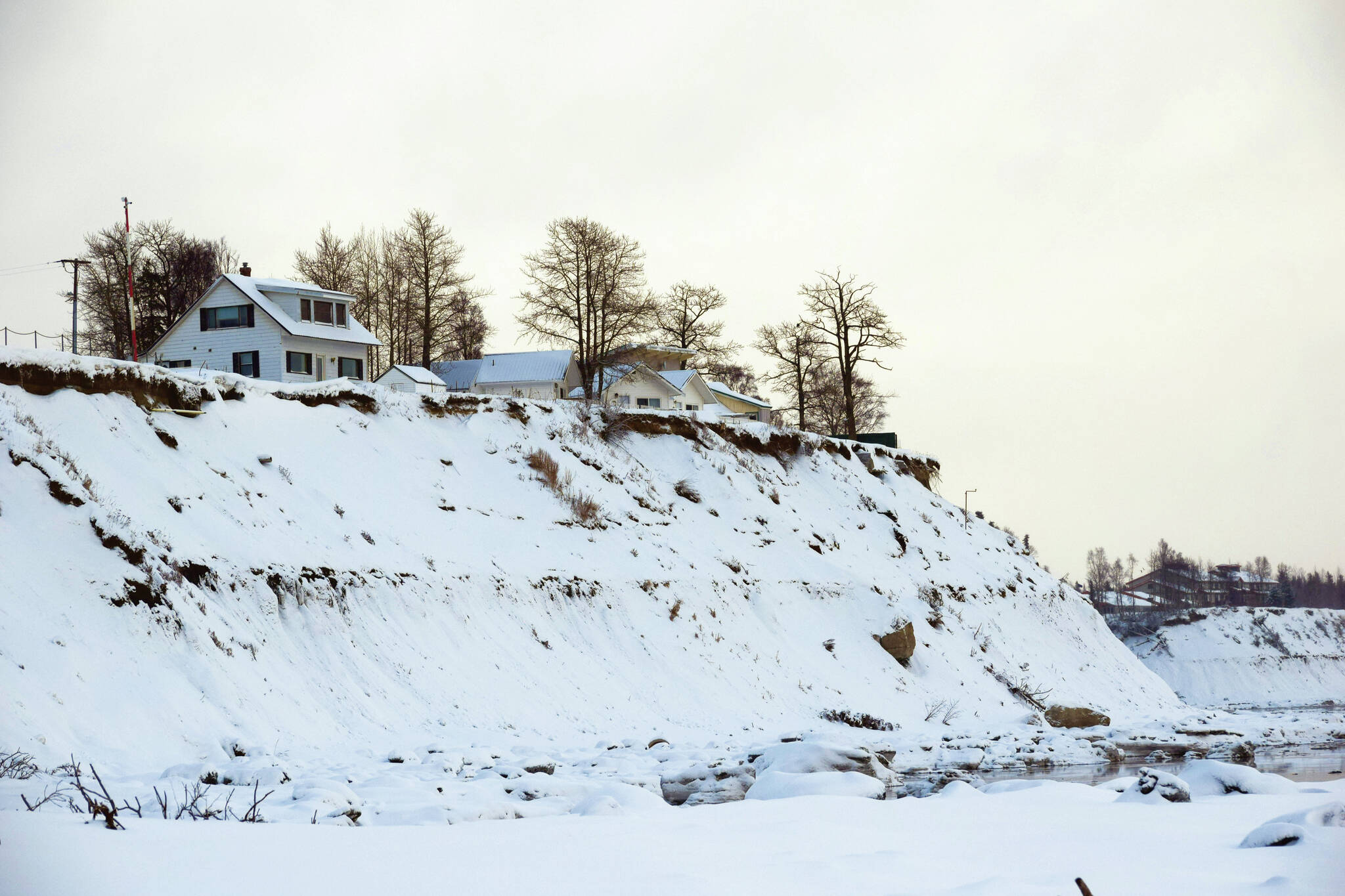Kenai Bluff erosion remains the City of Kenai’s top capital priority heading into the upcoming fiscal year. That’s per debate and approval over the city’s five-year capital plan by members of the Kenai City Council during the body’s March 16 meeting. Capital projects refer to those projects that typically require a one-time expenditure of more than $35,000 and which have a usable life of longer than one year.
The city’s Capital Improvement Plan outlines capital projects the city will prioritize in upcoming fiscal years. First on the list for the next two years is Kenai Bluff Stabilization. While the plan does not list projects in order of priority, Kenai City Council members made clear Wednesday that the project is at the top of their list.
The bluff is currently receding at a rate of about 3 feet per year, with the tentative stabilization plan to construct a berm at the toe of the bluff, per a recommendation from the Army Corps of Engineers. The total project cost will be split between the federal government, which will pay 65%, and the City of Kenai, which will pay 35%.
Kenai City Manager Paul Ostrander outlined how an influx of federal and state cash will help make the project a reality.
The Corps estimates that design and construction of the project will cost around $42 million, but Ostrander said he thinks the final total will be much lower. Using a projected total project cost of $35 million, the City of Kenai would contribute about $2.55 million to the project.
The remaining $32,450,000 of the total project cost would come from grants. Gov. Mike Dunleavy has included as part of his proposed fiscal year 2023 budget for the state $6.5 million for the project. Republican U.S. Sen. Lisa Murkowski secured an additional $28 million for the project through the federal Infrastructure Investment and Jobs Act.
Still, the project is only one element of the city’s five-year plan, which was developed by the city’s public works department with input from Kenai’s commissions and committees. The Kenai Harbor Commission, for example, reviewed the plan and requested that dredging of the Kenai River be included in the plan for fiscal year 2025. The city’s parks and recreation commission recommended moving the replacement of the city’s softball shelters and dugouts to the upcoming fiscal year.
Projects described in the city’s plan for the upcoming fiscal year include, in addition to bluff erosion, the rehabilitation of Willow Street and repairs to lighting along Lilac Street. Repair to a failed stormwater line on Aliak Drive and designs for the repair of runways at the Kenai Municipal Airport are also included.
Adoption of the plan does not allocate funds for projects, but rather allows city administrators to build the city’s budget around what projects it wants to prioritize, Kenai Finance Director Terry Eubank told council members Wednesday.
Council members clashed Wednesday over how much priority should be given to the design and construction of a lighted Nordic trail system at the Kenai Municipal Golf Course. In all, the project is estimated to cost $200,000 and is contingent on the award of grant funds.
Kenai Vice Mayor Jim Glendening proposed bumping the project from fiscal year 2023 to fiscal year 2024 in light of current debate in the U.S. Congress about daylight saving time. The U.S. Senate voted last week to make daylight saving permanent starting in 2023. That legislation must still be passed in the U.S. House of Representatives and then signed by President Joe Biden.
“That would add another hour of daylight to the Nordic trail and perhaps the lighting might not be necessary,” Glendening said.
Council member Teea Winger said she picks her kids up from school every day at four o’clock and that “all the skiers are returned to the shack during the daylight hours.” Winger said she would support the project if it was funded by grants and questioned whether it was “fiscally conservative” for taxpayers.
Ostrander stated multiple times that the project would only be constructed if grant funds were received and described the project’s inclusion in the plan as a “placeholder” that allows the city to pursue grant funds in the upcoming fiscal year. In the event grant funds do not become available, the project would roll into the following year, he said.
“If we don’t receive grant funding, that project won’t happen,” Ostrander said. “It’s entirely dependent on grant funding.”
The council ultimately voted 4-3 to leave the Nordic trail lighting where it was originally in the plan. The final plan was approved unanimously by council members. The city council’s full meeting can be streamed on the City of Kenai’s YouTube channel.
Reach reporter Ashlyn O’Hara at ashlyn.ohara@peninsulaclarion.com.

